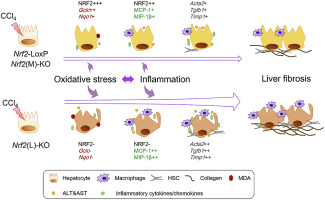当前位置:
X-MOL 学术
›
Free Radical Bio. Med.
›
论文详情
Our official English website, www.x-mol.net, welcomes your
feedback! (Note: you will need to create a separate account there.)
Hepatocyte-specific deficiency of Nrf2 exacerbates carbon tetrachloride-induced liver fibrosis via aggravated hepatocyte injury and subsequent inflammatory and fibrogenic responses.
Free Radical Biology and Medicine ( IF 7.1 ) Pub Date : 2020-02-26 , DOI: 10.1016/j.freeradbiomed.2020.02.015 Hang Lyu 1 , Huihui Wang 1 , Lu Li 1 , Jiayu Zhu 1 , Feng Chen 2 , Yannan Chen 1 , Cuijie Liu 1 , Jingqi Fu 1 , Bei Yang 3 , Qiang Zhang 4 , Yuanyuan Xu 1 , Jingbo Pi 1
Free Radical Biology and Medicine ( IF 7.1 ) Pub Date : 2020-02-26 , DOI: 10.1016/j.freeradbiomed.2020.02.015 Hang Lyu 1 , Huihui Wang 1 , Lu Li 1 , Jiayu Zhu 1 , Feng Chen 2 , Yannan Chen 1 , Cuijie Liu 1 , Jingqi Fu 1 , Bei Yang 3 , Qiang Zhang 4 , Yuanyuan Xu 1 , Jingbo Pi 1
Affiliation

|
BACKGROUND
Liver fibrosis, in which hepatocyte damage and inflammatory response play critical roles, is a physiological response to chronic or iterative liver injury and can progress to cirrhosis over time. Nuclear factor E2-related factor 2 (Nrf2) is a master transcription factor that regulates oxidative and xenobiotic stress responses as well as inflammation.
METHOD
To ascertain the cell-specific roles of Nrf2 in hepatocytes and myeloid lineage cells in the progression of liver fibrosis, mice lacking Nrf2 specifically in hepatocytes [Nrf2(L)-KO] and myeloid lineage cells [Nrf2(M)-KO] were generated to evaluate carbon tetrachloride (CCl4)-induced liver injury, subsequent inflammation and fibrosis. In addition, mouse primary hepatocytes were used to investigate the underlying mechanisms.
RESULTS
Nrf2-mediated antioxidant response in the liver is responsive to acute CCl4 exposure in mice. With repeated CCl4 administration, Nrf2(L)-KO, but not Nrf2(M)-KO, mice showed more severe liver fibrosis than Nrf2-LoxP control mice. In addition, in response to acute CCl4 exposure, Nrf2(L)-KO mice displayed aggravated liver injury, elevated lipid peroxidation and inflammatory response compared to control mice. In mouse primary hepatocytes, deficiency of Nrf2 resulted in more severe CCl4-induced lipid oxidation and inflammatory response.
CONCLUSION
Deficiency of Nrf2 in hepatocytes sensitizes the cells to CCl4-induced oxidative damage and inflammatory response, which are initiator and enhancer of subsequent hepatic inflammation and fibrosis. Thus, Nrf2 is a critical determinant of liver injury and fibrosis in response to CCl4, suggesting that Nrf2 might be a valuable target for the intervention.
中文翻译:

Nrf2的肝细胞特异性缺乏通过加剧的肝细胞损伤以及随后的炎症和纤维化反应,加剧了四氯化碳诱导的肝纤维化。
背景技术肝纤维化在肝细胞损伤和炎性反应中起关键作用,是对慢性或反复性肝损伤的生理反应,并且随着时间的流逝可发展为肝硬化。核因子E2相关因子2(Nrf2)是一个主转录因子,可调节氧化和异源应激反应以及炎症。方法为确定肝纤维化进程中肝细胞和髓系细胞中Nrf2的细胞特异性作用,分别在肝细胞[Nrf2(L)-KO]和髓系细胞[Nrf2(M)-KO]中缺乏Nrf2的小鼠用于评估四氯化碳(CCl4)诱导的肝损伤,随后的炎症和纤维化。此外,小鼠原代肝细胞被用来研究其潜在机制。结果肝脏中Nrf2介导的抗氧化反应对小鼠的急性CCl4暴露有反应。重复施用CCl4,Nrf2(L)-KO,而不是Nrf2(M)-KO,小鼠显示出比Nrf2-LoxP对照小鼠更严重的肝纤维化。此外,响应于急性CCl4暴露,与对照组小鼠相比,Nrf2(L)-KO小鼠表现出严重的肝损伤,脂质过氧化和炎症反应增强。在小鼠原代肝细胞中,Nrf2的缺乏导致更严重的CCl4诱导的脂质氧化和炎症反应。结论肝细胞中Nrf2的缺乏使细胞对CCl4诱导的氧化损伤和炎症反应敏感,这是随后肝炎和纤维化的引发剂和增强剂。因此,Nrf2是响应CCl4引起肝损伤和纤维化的关键决定因素,
更新日期:2020-02-26
中文翻译:

Nrf2的肝细胞特异性缺乏通过加剧的肝细胞损伤以及随后的炎症和纤维化反应,加剧了四氯化碳诱导的肝纤维化。
背景技术肝纤维化在肝细胞损伤和炎性反应中起关键作用,是对慢性或反复性肝损伤的生理反应,并且随着时间的流逝可发展为肝硬化。核因子E2相关因子2(Nrf2)是一个主转录因子,可调节氧化和异源应激反应以及炎症。方法为确定肝纤维化进程中肝细胞和髓系细胞中Nrf2的细胞特异性作用,分别在肝细胞[Nrf2(L)-KO]和髓系细胞[Nrf2(M)-KO]中缺乏Nrf2的小鼠用于评估四氯化碳(CCl4)诱导的肝损伤,随后的炎症和纤维化。此外,小鼠原代肝细胞被用来研究其潜在机制。结果肝脏中Nrf2介导的抗氧化反应对小鼠的急性CCl4暴露有反应。重复施用CCl4,Nrf2(L)-KO,而不是Nrf2(M)-KO,小鼠显示出比Nrf2-LoxP对照小鼠更严重的肝纤维化。此外,响应于急性CCl4暴露,与对照组小鼠相比,Nrf2(L)-KO小鼠表现出严重的肝损伤,脂质过氧化和炎症反应增强。在小鼠原代肝细胞中,Nrf2的缺乏导致更严重的CCl4诱导的脂质氧化和炎症反应。结论肝细胞中Nrf2的缺乏使细胞对CCl4诱导的氧化损伤和炎症反应敏感,这是随后肝炎和纤维化的引发剂和增强剂。因此,Nrf2是响应CCl4引起肝损伤和纤维化的关键决定因素,











































 京公网安备 11010802027423号
京公网安备 11010802027423号